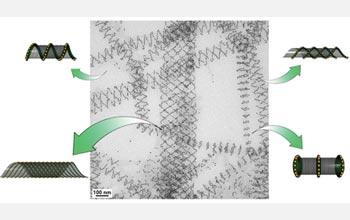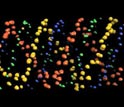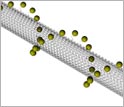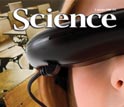News Release 08-221
Mother Nature Knows Nano
Scientists use DNA and gold particles to engineer nanotube structures

Many different nanotube conformations were observed in a single TEM image.
January 1, 2009
View a video of the 3D architecture of nanotubes formed with 5 nm and 10 nm AuNPs (gold particles).
This material is available primarily for archival purposes. Telephone numbers or other contact information may be out of date; please see current contact information at media contacts.
The future of the nanotechnology field depends on our ability to reliably and reproducibly assemble nanoparticles into 3D structures we can use to develop new technologies. According to Hao Yan and Yan Liu at Arizona State University, the greatest challenges in this burgeoning field include control over nanoscale 3D structure and imaging these tiny materials.
"The ability to build predicted structures and provide experimental feedback to current theories is critical to the nanotechnology field," said Yan.
One approach to production of nanoscale architecture is creation of nanoparticles that assemble themselves into the desired structure. DNA molecules are an elegant biological example of small particles that self-assemble to form higher order 3D structures.
Inspired by this prototype, Yan and colleagues looked to Mother Nature to solve their nano-sized problem. They attached gold nanoparticles to DNA, taking advantage of its self-assembling biochemical properties to engineer nanotubes that form a number of different 3D structures. The researchers manipulated nanotube size and shape by changing the size of the gold particles attached to the DNA or the DNA structure itself. Anchi Cheng at the Scripps Research Institute contributed to the project by imaging the 3D conformations of nanotube structures using cryo-Electron Tomography
This National Science Foundation-supported research is published in the January 2 issue of Science magazine.
Yan is hopeful this groundbreaking work will serve as the foundation on which emerging fields and new technologies may be built. "Now that we have methods to alter the periodicity, diameter and chirality of nanotube formation, we can use what we have learned to control hierarchical assembly of these building blocks to create more complex 3D structures," he said.
In the future, use of nanotubes may reduce the size of cell phones and other electronic devices even further. Scientists also envision using nanotubes for a number of biological applications including gene and drug delivery. Drugs or other treatments specifically delivered using nanotubes would target only affected tissues, potentially eliminating toxic side effects.
-NSF-
-
View Video
Movie showing the 3D architecture of nanotubes formed with 5 nm and 10 nm AuNPs (gold particles).
Credit and Larger Version -
This cartoon depicts a single nanotube formed from DNA tile arrays with gold particles attached.
Credit and Larger Version -
The researchers' findings appear in the January 2, 2009, issue of Science.
Credit and Larger Version
Media Contacts
Bobbie Mixon, NSF, (703) 292-8070, email: bmixon@nsf.gov
Lisa Van Pay, NSF, (703) 292-8796, email: lvanpay@nsf.gov
Principal Investigators
Hao Yan, Arizona State University, (480) 727-8570, email: hao.yan@asu.edu
The U.S. National Science Foundation propels the nation forward by advancing fundamental research in all fields of science and engineering. NSF supports research and people by providing facilities, instruments and funding to support their ingenuity and sustain the U.S. as a global leader in research and innovation. With a fiscal year 2023 budget of $9.5 billion, NSF funds reach all 50 states through grants to nearly 2,000 colleges, universities and institutions. Each year, NSF receives more than 40,000 competitive proposals and makes about 11,000 new awards. Those awards include support for cooperative research with industry, Arctic and Antarctic research and operations, and U.S. participation in international scientific efforts.
Connect with us online
NSF website: nsf.gov
NSF News: nsf.gov/news
For News Media: nsf.gov/news/newsroom
Statistics: nsf.gov/statistics/
Awards database: nsf.gov/awardsearch/
Follow us on social
Twitter: twitter.com/NSF
Facebook: facebook.com/US.NSF
Instagram: instagram.com/nsfgov



